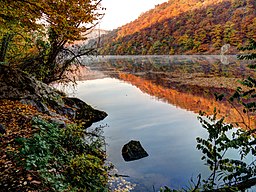Podyjí
| Podyjí National Park | |
| Czech: Národní park Podyjí | |
| National Park | |
| Country | Czech Republic |
|---|---|
| Region | South Moravian |
| Highest point | |
| - elevation | 536 m (1,759 ft) |
| Lowest point | |
| - elevation | 207 m (679 ft) |
| Length | 15 km (9 mi), NW-SE |
| Width | 8 km (5 mi), NE-SW |
| Area | 63 km2 (24 sq mi) |
| - buffer zone | 29 km2 (11 sq mi) |
| Biome | forest (84%) |
| Founded | 1991-07-01 |
| - CHKO | 1978 |
| Management | Správa NP Podyjí |
| - location | Znojmo |
| Website: www.nppodyji.cz | |
Podyjí National Park (Czech: Národní park Podyjí) is a national park in the South Moravian Region of the Czech Republic. Adjacent to Austria's Thayatal National Park on the border, together they are referred to as the Inter-National park. Podyjí is one of the Czech Republic's four national parks. It protects near-natural forests along the deep Dyje River valley. The well-preserved state of the biome of the park is cited as being unique in Central Europe.
Podyjí National Park is one of the four national parks of the Czech Republic. It has an area of 63 square kilometres (24 sq mi) and buffer zone of 29 square kilometres (11 sq mi). It was formally declared a national park 1 July 1991 by government order no. 164/1991.BirdLife International (IBA) has included this park under its criteria C6 covering a larger area of 76.66 square kilometres (29.60 sq mi).
Podyjí National Park lies in an elevation range of 534–214 metres (1,752–702 ft). Its habitats include forest, grassland, arable land, shrubland, rocky areas and inland wetlands. The park is drained by the Dyje River, which flows for a length of 40 kilometres (25 mi) through the park in a thickly-forested valley within the Českomoravská vrchovina uplands. The river valley's depth measures up 220 metres (720 ft). Land use has been established for nature conservation and research, forestry and agriculture. Park trails lead to the castle ruins of Nový Hrádek, Hardegg Castle, and Vranov nad Dyjí Chateau.
The park's valley is home to 77 species of plants, which include oak woods (acidophilous and temperate type), hornbeam, beech, and alder. Some of the perennial flowering species are cyclamen, mulleins, and pasque flower. The upper plateau, which was denuded by logging and converted to cultivable land, contains grasslands. Along the river beds, reed-beds or willow shrubs are noted. Eighteen species of orchids have been recorded.
...
Wikipedia


